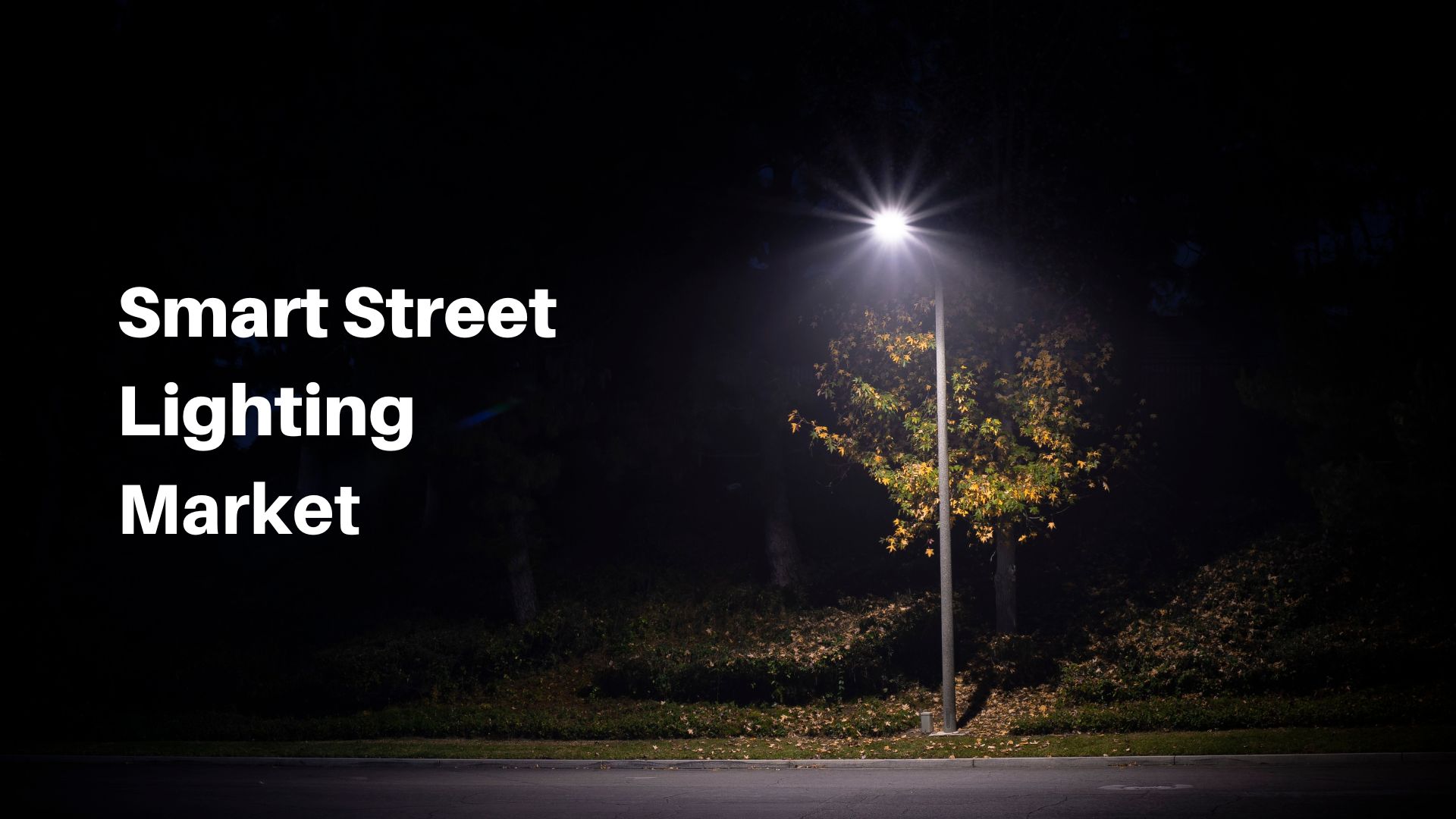Smart Street Lighting Market to Reach USD 2.41 Billion by 2032, Says Market.us Research Study

Page Contents
Market Overview
Published Via 11Press: In 2022, the smart street lighting market was estimated to be worth USD 2.41 billion and reach its peak value of USD 13.4 billion by 2032 at a compound annual growth rate (CAGR) of 19.2% between 2022 and 2032.
The global smart street lighting market is expected to witness significant growth over the forecast period due to rising demand for energy-saving lighting solutions. Governments and municipalities around the world are adopting smart street lighting systems in an effort to reduce energy consumption and lower costs. These systems make use of advanced technologies like sensors, wireless communication, and cloud computing for real-time monitoring and control of lighting infrastructure.
The global smart street lighting market is expected to experience rapid growth over the coming years, driven by expanding adoption of smart city initiatives around the world. These systems help save energy, cut costs, and enhance safety by automatically adjusting light levels based on factors such as traffic volume, weather conditions, and pedestrian activity.
LED lighting solutions are expected to dominate the market share in the coming years due to their energy efficiency and longer lifespan compared to traditional lighting solutions. Furthermore, the incorporation of Internet of Things (IoT) technology into smart street lighting systems will further fuel market expansion. IoT allows for real-time data collection from sensors and other devices which can be utilized for optimizing lighting levels while reducing energy consumption.

Key Takeaways
- The global smart street lighting market is projected to experience a compound annual growth rate (CAGR) of 19.2% during the forecast period.
- This growth is being spurred on by government initiatives for energy conservation, cost savings, and the demand for sustainable lighting solutions.
- LED lighting is expected to lead the market due to its energy efficiency, long lifespan, and minimal upkeep requirements.
- The asia-Pacific region is projected to experience the highest growth due to increasing urbanization and rising investments in smart city projects.
Drivers, trends, and challenges have an impact on market dynamics, which can impact businesses. Request for PDF sample report
Regional Snapshot
North America accounts for the majority of the market share due to its abundance of major vendors and sophisticated infrastructure. The United States is by far the leading contributor to this region's market size.
- Europe: This region is expected to experience substantial growth due to increased government initiatives for smart city development.
- Asia-Pacific: This region is projected to experience the highest growth due to rising investments in smart city projects and increased adoption of LED lighting solutions in countries such as China, India, and Japan.
- Middle East & Africa: This region is expected to experience rapid growth due to the increasing adoption of smart city projects and demand for energy-saving lighting solutions.
Drivers
- Energy Efficiency: Smart street lighting systems use energy-saving LED bulbs that use less electricity than traditional streetlights, leading to significant savings for municipalities and local governments while helping reduce carbon emissions.
- Cost Savings: Smart street lighting systems can help save maintenance expenses by remotely monitoring and diagnosing faults in the network. This leads to faster repairs and reduced downtime, leading to cost savings for cities and towns.
- Safety and Security: Smart street lighting systems can improve public safety by providing better illumination, particularly in dimly lit areas. Furthermore, these systems may be equipped with sensors that detect potential security threats and alert authorities accordingly.
- Smart City Initiatives: Cities around the world are investing in smart city initiatives, which include installing smart street lighting systems. This trend is expected to continue over the coming years, propelling growth in the smart street lighting market.
Restraints
- High Initial Investment: Deploying smart street lighting systems necessitates a significant initial investment, which may prove prohibitive for some municipalities and local governments.
- Absence of Standards: Unfortunately, there is currently a lack of standardization in the smart street lighting market, leading to compatibility issues between different systems. This makes it challenging for cities to select an appropriate vendor and delays the deployment of these systems.
- Data Privacy Issues: Smart street lighting systems can collect a lot of data about the environment and people nearby. This poses privacy issues for citizens, so governments need to be transparent with how this data is collected, stored, and used.
Opportunities
- Energy-Efficient Lighting System: Smart street lighting systems can save significant amounts of energy by only turning on lights when necessary, dimming lights during low foot traffic hours, and using LED bulbs.
- Cost Savings: Implementing smart street lighting systems can result in savings on energy bills, maintenance fees, and installation expenses over time.
- Improved Safety: Brighter and more consistent illumination improves safety for drivers as well as pedestrians alike.
- Reduced Light Pollution: Smart street lighting systems can be designed to minimize light pollution by directing illumination where it's most needed and cutting back on unnecessary output.
Challenges
- High Upfront Costs: Installing smart street lighting systems can be costly, necessitating a substantial upfront investment.
- Technical Complexity: Smart street lighting requires sophisticated sensors and networking technology that may prove challenging to implement or maintain over time.
- Security Risks: Like any Internet of Things device, smart street lighting systems may be vulnerable to cyber attacks if not properly secured.
- Public Acceptance Issues: Some members of the public may be skeptical about new technology or fail to see its potential advantages.
Recent Developments
- Integration with Other Smart City Systems: Smart street lighting systems is increasingly being integrated with other smart city systems, such as traffic management and public safety ones.
- Utilizing Artificial Intelligence (AI): AI can be employed to optimize lighting levels based on factors like weather conditions, time of day, and traffic patterns.
- Wireless Connectivity: Many smart street lighting systems now incorporate wireless connectivity which enables them to be remotely managed and monitored.
- Energy Storage: Many smart street lighting systems now incorporate energy storage solutions, such as batteries or solar panels, to reduce reliance on the electrical grid and maximize efficiency.
Key Market Segments
Type
- PLC
- RF Controls
Application
- Tourist Attractions
- Schools
- Parks
- Urban Roads
- Others
Key Market Players
- Bridgelux
- TVILIGHT
- Philips
- OSRAM
- GE Lighting
- TCOMM
- Silver Spring
- Echelon Corporation
- Petra Systems
- VISION
- Cyan Technology
- SHAH
- Telematics
- ONTAZ
- SELC
- Flashnet
Report Scope
| Report Attribute | Details |
| The market size value in 2022 | USD 2.41 Bn |
| Revenue forecast by 2032 | USD 13.4 Bn |
| Growth Rate | CAGR Of 19.2% |
| Regions Covered | North America, Europe, Asia Pacific, Latin America, and Middle East & Africa, and Rest of the World |
| Historical Years | 2017-2022 |
| Base Year | 2022 |
| Estimated Year | 2023 |
| Short-Term Projection Year | 2028 |
| Long-Term Projected Year | 2032 |
Frequently Asked Questions
Q: How do smart street lighting systems function?
A: Smart street lighting uses sensors and communication technology to monitor and adjust light levels based on factors like traffic patterns, time of day, and weather conditions. They can also be remotely controlled and managed for added convenience.
Q: Are smart street lighting systems more costly than traditional ones?
A: Yes, initially they may be more costly than their counterparts, but over time you save money through reduced energy bills and maintenance expenses.
Q: Can smart street lighting systems enhance public safety?
A: Absolutely, brighter and more consistent illumination can increase safety for both drivers and pedestrians alike.
Q: Are there any security risks associated with smart street lighting systems?
A: Yes, as with any Internet of Things device, smart street lighting systems may be vulnerable to cyber attacks if not properly secured.
Q: Do smart street lighting systems reduce light pollution?
A: Yes, smart street lighting systems can be designed to minimize light pollution by directing illumination where it's most needed and decreasing unnecessary output of illumination.
The team behind market.us, marketresearch.biz, market.biz and more. Our purpose is to keep our customers ahead of the game with regard to the markets. They may fluctuate up or down, but we will help you to stay ahead of the curve in these market fluctuations. Our consistent growth and ability to deliver in-depth analyses and market insight has engaged genuine market players. They have faith in us to offer the data and information they require to make balanced and decisive marketing decisions.



